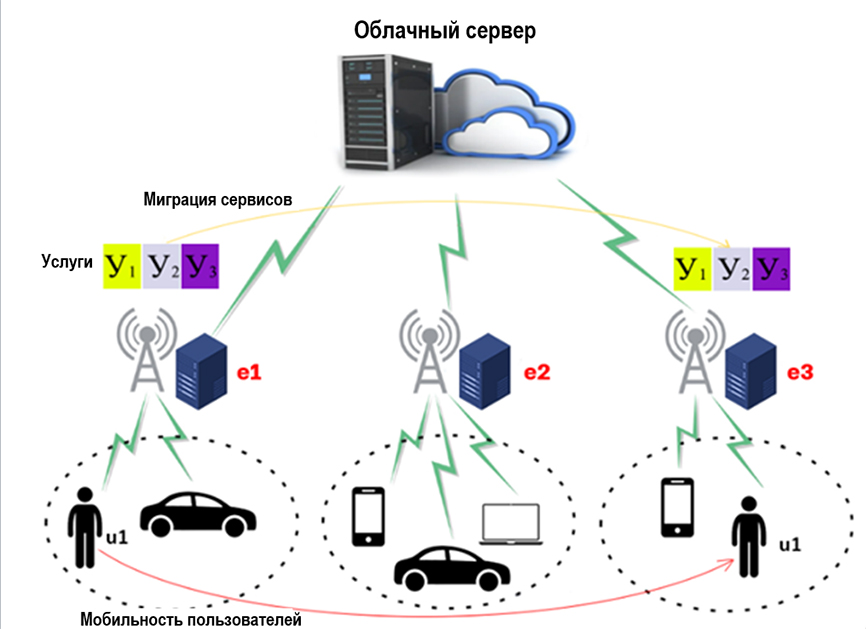
Intelligent Serverless Computing System for Telepresence Services
https://doi.org/10.31854/1813-324X-2025-11-4-18-27
EDN: UOYTAY
Abstract
Relevance. This article addresses the problem of Joint Service Migration and Resource Allocation (SMRA) optimization in a Multi-access Edge Computing (MEC) environment, aiming to reduce latency in telepresence systems. MEC enhances cloud computing capabilities by relocating services to the network edge, as close as possible to users, thus resolving access latency issues. However, the high mobility of devices and the limited resources of edge servers complicate the maintenance of Quality of Service. The service migration process itself introduces additional latency, and different servers and user devices have their own unique requirements and resource allocation policies, necessitating a balanced approach to solving this problem. Despite advancements in the field of telepresence, such as high-quality video and spatial audio, virtual reality, and augmented reality, the effective operation of these systems requires a robust infrastructure and minimal interaction delays.
Problem statement. In this work, we propose a joint SMRA+MEC algorithm that considers the specific characteristics of telepresence systems and addresses the problem of optimal resource allocation and the necessity of service migration.
Purpose of the work. Development and evaluation of the effectiveness of a joint SMRA+MEC algorithm adapted for telepresence systems.
Methods used. To achieve the stated goal, mathematical models will be used in this work to formalize the SMRA+MEC problem, taking into account the parameters of telepresence systems.
The results show that the proposed algorithm achieves a significant latency reduction of 50 %.
Scientific novelty. A novel method for calculating latency is presented, which allows for minimizing latency and allocating resources more optimally. It is shown that combining SMRA+MEC methods is the most effective approach to latency minimization.
Practical significance. The developed SMRA+MEC algorithm can be used by mobile operators to optimize the deployment and management of MEC infrastructure, providing high-quality service for telepresence applications.
About the Authors
Z.A. H. Al-KereaRussian Federation
А.S. A. Muthanna
Russian Federation
А. Е. Koucheryavy
Russian Federation
References
1. Ateya A.A., Abd El-Latif A.A., Muthanna A., Volkov A., Koucheryavy A. Enabling Metaverse and Telepresence Services in 6G Networks. New York: CRC Press; 2025. DOI:10.1201/9788770046749
2. Thang D.V., Volkov A., Muthanna A., Koucheryavy A., Ateya A.A., Jayakody D.N.K. Future of Telepresence Services in the Evolving Fog Computing Environment: A Survey on Research and Use Cases. Sensors. 2025;25(11):3488. DOI:10.3390/s25113488
3. Van Thang D., Volkov A., Muthanna A., Elgendy I.A., Alkanhel R., Jayakody D.N.K., Koucheryavy A. A Framework Integrating Federated Learning and Fog Computing Based on Client Sampling and Dynamic Thresholding Techniques. IEEE Access. 2025;13: 95019‒95033. DOI:10.1109/ACCESS.2025.3571979
4. Taleb T., Samdanis K., Mada B., Flinck H., Dutta S., Sabella D. On Multi-Access Edge Computing: A Survey of the Emerging 5G Network Edge Cloud Architecture and Orchestration. IEEE Communications Surveys & Tutorials. 2017;19(3):1657–1681. DOI:10.1109/COMST.2017.2705720
5. Chistova N.A., Paramonov A.I., Koucheryavy A.E. The method of forming the digital clusters for communication networks of fifth and subsequent generations based on QoS. Electrosvyaz. 2020;7:22‒28. (in Russ.) DOI:10.34832/ELSV.2020.8.7.003. EDN:QDEUQG
6. Yu H., Ming Z., Wang C., Taleb T. Network Slice Mobility for 6G Networks by Exploiting User and Network Prediction. Proceedings of the International Conference on Communications, ICC, 28 May ‒ 01 June 2023, Rome, Italy. IEEE; 2023. DOI:10.1109/ICC45041.2023.10279739
7. Addad R.A., Dutra D.L.C., Taleb T., Flinck H. Toward Using Reinforcement Learning for Trigger Selection in Network Slice Mobility. IEEE Journal on Selected Areas in Communications. 2021;39(7):2241–2253. DOI:10.1109/jsac.2021.3078501. EDN:UGJVKC
8. Volkov A.N., Muthanna A.S.A., Kucheryavy A.E., Borodin A.S., Paramonov A.I., Vladimirov S.S. et al. Perspective research of networks and services 2030 in the laboratory 6G MEGANETLAB SPBSUT. Electrosvyaz. 2023;6:5‒14. (in Russ.) DOI:10.34832/ ELSV.2023.43.6.001. EDN:CJSYLS
9. Hu L., Tian Y., Yang J., Taleb T., Xiang L., Hao Y. Ready Player One: UAV-Clustering-Based Multi-Task Offloading for Vehicular VR/AR Gaming. IEEE Network. 2019;33(3):42–48. DOI:10.1109/MNET.2019.1800357
10. Chen Y., Sun Y., Wang C., Taleb T. Dynamic Task Allocation And Service Migration in Edge-Cloud IoT System Based on Deep Reinforcement Learning. IEEE Internet of Things Journal. 2022;9(18):16742–16757. DOI:10.1109/JIOT.2022.3164441. EDN:XSAUUL
11. Ming Z., Li X., Sun C., Fan Q., Wang X., Leung V.C.M. Dependency-Aware Hybrid Task Offloading in Mobile Edge Computing Networks. Proceedings of the International Conference on Parallel and Distributed Systems, ICPADS, 14‒16 December 2021, Beijing, China. IEEE; 2021. p.225–232. DOI:10.1109/ICPADS53394.2021.00034
Review
For citations:
Al-Kerea Z.H., Muthanna А.A., Koucheryavy А.Е. Intelligent Serverless Computing System for Telepresence Services. Proceedings of Telecommunication Universities. 2025;11(4):18-27. (In Russ.) https://doi.org/10.31854/1813-324X-2025-11-4-18-27. EDN: UOYTAY


































